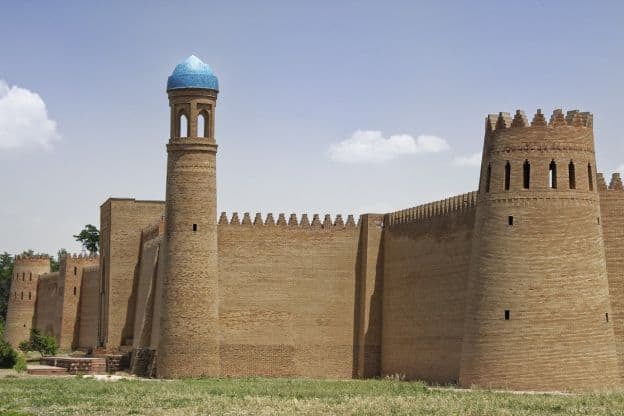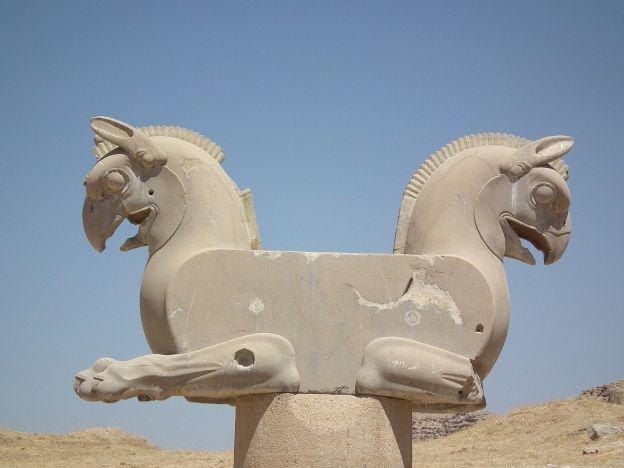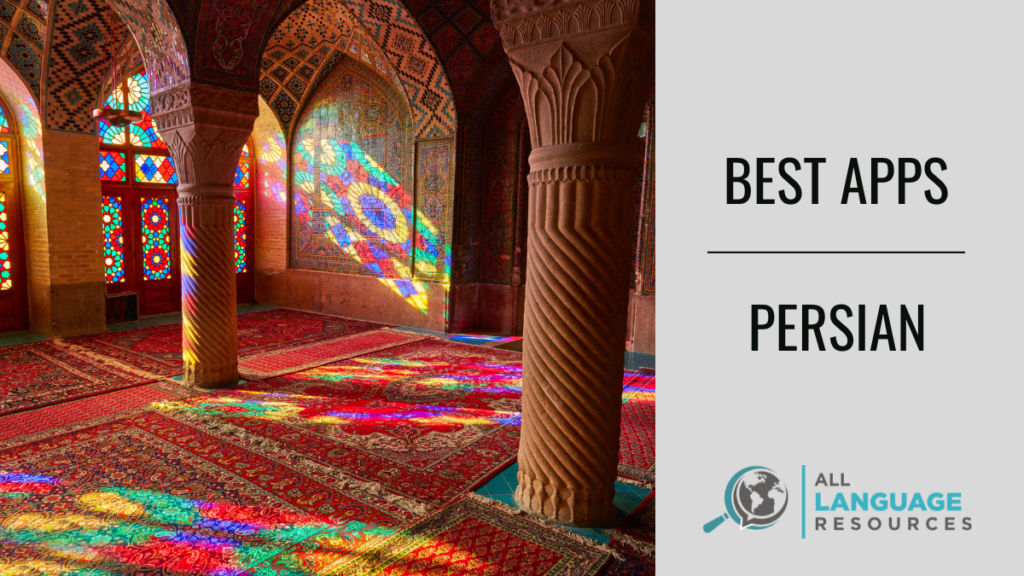Persian, also known as Farsi in Iran, Dari in Afghanistan, and Tajik in Tajikistan, has over 60 million native speakers, and another 50 million or more speak it as a second language. It ranks among the most spoken languages in the Middle East.
Although the Persian language shares some similarities with Arabic, they are not the same. Despite the differences in both languages, Persian is just as rich and fascinating to explore.
Why are you studying Persian? Is it for the rich and diverse culture, to connect with Persian natives, or to understand more of its rich history, culture, and art? Regardless of the reasons, you need resources that cater to your learning needs and learning style.
Keep reading as we share some great Persian courses, apps, podcasts, and YouTube channels for you to check out.
Table of Contents
Persian(Farsi) Resources, Scripts & Cyrillic Alphabet, Write & type in Persian · Learn Farsi with these apps, courses, tutors, YouTube, podcasts, and more.
Resources for Learning Farsi(Persian) Online
Where to learn Persian(Farsi)? Let’s take a look at the many resources that will help you progress in your quest for Persian fluency.
Farsi Language Courses
Taking a Persian course can help you build a foundation in the language. While some courses focus primarily on phrases, which might be especially useful for travelers, other courses will help you learn both vocabulary and grammar. The structure provided by several of these courses will give you a deeper understanding of how the language works.
At the present time, gamified language-learning platform Duolingo has not developed a Persian course. Nor have Babbel, Busuu, or LingoDeer, among other popular platforms.

Rudkhan Castle, Gilan Province, Iran
That said, there are many alternatives to Duolingo and similar products. These alternatives have different price points and features. Many of the paid products come with a free trial, so you can try out different resources to see what suits you.
Learn Farsi for Free With These Courses
A few of these courses are designed as completely free resources. Others work like Duolingo and Memrise, in that you can enjoy them indefinitely without charge — albeit with some limited features that are unlocked at the paid tiers.
Persian Language Online offers free lessons for beginners, those at an elementary level, and intermediate learners. Most lessons consist of a short video introducing a concept.
One potential drawback is that the video lessons themselves are not captioned, in either Persian or English. However, you may listen to the audio from the lesson while reading the corresponding Persian or English text. A glossary lists out the vocabulary from each lesson, with its translation and an audio clip for pronunciation help, and there are additional dialogues to study.

Young women in Mellat Park, Mashhad, Iran
Some of these lessons highlight the differences between spoken and written language and include tips on grammar. There are a few interactive activities, like fill-in-the-blank exercises, so you can practice what you’ve learned in each lesson.
Mango Languages has a Persian (Farsi) course that’s available for free through many public libraries in North America. You can use the Find Mango locator to find out if you have access to a free Mango Languages subscription through your local public library, school system, or other municipal organization. The Mango Languages course only covers the basics for beginners, but it can give you a start with written dialogues, audio, grammar lessons, and culture tips. You can access Mango Languages through a web browser or a mobile app (for either Android or iOS devices).
Courses from both the Foreign Service Institute and the Defense Language Institute are available for free through the Live Lingua Project. You can also find Peace Corps Persian language lessons on the Live Lingua Project site, although they lack the audio files provided for the FSI and DLI courses.
In general, we have found both the FSI and DLI courses to be solid, comprehensive resources. Their biggest drawback is their age — and the fact that they don’t include interactive exercises. If you are a logical-mathematical or verbal-linguistic learner, you will probably appreciate the in-depth grammar and phonetics notes provided by the Spoken Persian (Farsi) course from FSI.
For those who wish to learn the Dari Persian standard spoken in Afghanistan, the Persian Kabul course from DLI would be particularly helpful.
Similar to the FSI and DLI courses is the Tajiki Familiarization Course, developed by the Joint Base Lewis-McChord Language and Culture Center. The JBLM Tajiki course isn’t fancy, but its free curriculum includes cultural notes, grammar, and vocabulary, as well as written exercises with answer keys and audio files to help with pronunciation. You can access it without a login.

Citadel in Hulbuk, Tajikistan
When it comes to course diversity, it’s hard to beat language-learning giant Memrise. Not only will you find many courses for Persian in general and the Iranian Farsi standard, along with several courses specifically for Afghan Dari Persian, you’ll even get access to Tajiki Persian courses.
There are varying levels of quality and completeness, as many of these are community-contributed courses. Still, the Memrise interface is easy to navigate — especially on iOS or Android mobile devices — and the spaced repetition is a powerful way to make new vocabulary stick.
Some courses come with native audio. Memrise courses will generally not teach you a lot about grammar or cultural context, however.
Tajiki learners can expect fewer resources than those available for the Farsi or Dari Persian standards. Polymath, ilanguages, and My Languages have similar content in their Tajiki lessons, and all lack audio examples for the vocabulary presented. However, they might help you get your feet wet with a few basics of the language.
Paid Farsi Language Courses
Pimsleur, based on the linguistic work of Dr. Paul Pimsleur, is primarily an audio course. This focus will help you concentrate on conversation and might be particularly appealing for auditory learners. We believe that the lessons are structured well, although there is very little visual content — so you may need to supplement with other materials to build your mastery of the written language. Pimsleur offers both Dari Persian (Afghan standard) and Farsi Persian (Iranian standard) as separate courses.

Afghan men wearing the traditional pakol hats
If you’re looking to learn Persian for travel and you’re interested in building your vocabulary with set phrases, uTalk might be a good choice for you. While it’s phrase-based and probably won’t give you a fully comprehensive mastery of Persian, we found that it had helpful native audio for pronunciation examples and plenty of opportunities to hear yourself speaking. uTalk has plans for learning Dari, Farsi (Tehranian accent), and even Tajiki.
PersianPod101, from Innovative Language, is a pretty solid program that might appeal to auditory learners in particular. The lessons are presented in a podcast style, often using a conversation between two hosts, along with some video. Cultural information and conversational Persian are included in the program, as well as some grammar information. Overall, we found that PersianPod101 works best as a supplementary resource to a more traditional course.

Listening to a Persian podcast
Based in Yerevan, Armenia, Aspirantum has a 2-week, online course for upper-intermediate Persian speakers. Learn Persian Through the Shahname is targeted at learners who are nearly at an advanced level in Persian. The course is structured around one of the best-known epic Persian poems.
If you’re a serious learner who’d prefer a more immersive, intensive, in-person experience, consider a course like the 16-week Persian Language Semester from Aspirantum. While this course has a hefty price tag, it comes with over three hundred hours of instruction — as well as practice listening, speaking, reading, and writing.
Farsi Courses with Caveats
Based on our reviews of these resources, these courses might not provide the best experience for Persian learners. Still, some learners may still find them a valuable part of their Persian studies.
Rosetta Stone, a well-recognized name in language learning, offers a Persian (Farsi) course. Visual learners may like its picture-based approach, and the lessons are fairly well-organized. However, in our experience, Rosetta Stone lacks guidance for learning grammar or a way to practice making your own sentences — and its repetitive approach to language learning could quickly become dull.

Tehran, Iran (aerial view)
You can access Glossika’s Persian course, along with courses for many other languages, through a subscription — although some learners may find the monthly price tag a bit on the steep side. In addition, Glossika tends not to provide a lot of specific cultural information, taking somewhat of a cookie-cutter approach to course design. We also found the Glossika courses to be deficient in grammar explanations and prone to errors in the material.
17 Minute Languages has a Persian course that claims to give you conversational skills within four hours and fluency within fifty hours. In our experience with this resource, its greatest strength is its native-speaker audio. Beyond that, we found that courses from 17 Minute Languages tend to be error-ridden, hard to navigate, uninteresting, and lacking in decent explanations of the target language.
Cudoo’s courses seem to be based on generic slideshow presentations without cultural context or useful explanations. Persian (Farsi) is one of over 160 languages offered on the Cudoo platform, which also hosts course material on topics as diverse as entrepreneurship, health and safety certification, psychology, and accounting.
Bluebird Languages offers Dari, Persian (Farsi), and Tajiki, among dozens of other languages. While the native audio was a bonus for learning pronunciation, we felt that the lessons lacked cultural specificity and that the phrases taught were not put into useful contexts.
Like Cudoo and Bluebird Languages, Transparent Language offers lessons for a staggeringly large number of languages, among which are the Farsi, Dari, and Tajiki standards of Persian. Despite the rich variety of this linguistic Smörgåsbord, we were not impressed with Transparent Language’s offerings. Overall, their generic curriculum made no provision for learning grammar, cultural specifics, or vocabulary in context.
Language Exchange Apps
To become proficient in oral Persian, it’s best to find a speaking partner so you can practice both live listening and speaking. We’ve reviewed several language exchange apps, and find Tandem, HelloTalk, My Language Exchange, and Speaky to be solid choices.

Speaking Persian with a conversation partner
Farsi Language Tutor Marketplaces and Sites
If you’d like a one-to-one learning experience with a tutor, you have several options. We consider italki, Verbling, and Preply to be three of the most reliable online resources for connecting with a qualified tutor.
At this time, however, both Preply and Verbling appear to have tutors only for the Farsi Persian standard, and there are only a few Dari and Tajiki tutors available on italki. The situation is much the same with University Tutor, a resource we haven’t yet had the opportunity to test.
For Tajiki learners, who often have challenges finding all kinds of learning resources, the Native Monks website arranges paid tutoring sessions over Skype.
Farsi Learning Apps and Tools
Apps are a convenient, portable way to take your Persian learning with you on the go. There are several of varying quality available for both Android and iOS devices. Learn Farsi with these Apps:
Complete Language Course Apps
These apps generally combine lessons in vocabulary, grammar, and pronunciation, to give you a course-like experience in a mobile package.
Iranian Persian (Farsi) Standard
Learn Persian: Language Course by Mondly got high marks from both Google Play and Apple Store customers. (We were not equally impressed when we tested Mondly.) You can try it on iOS or Android.
Learn Farsi Persian by LuvLingua has a kid-friendly design, and seems to be well-liked by users. Get it for your Android or iOS device.
Other top user-rated picks for Android include Learn Persian Farsi Free by MetaLanguage, Learn Persian by Edu Technologies, and Learn Persian Free by InnovationApps.
Afghan Persian (Dari) Standard
For Dari learners with an Android device, three of the top-rated apps in the Google Play store are Learn Dari by Massoud Khaja, Dari – LSK by the Defense Language Institute, and Learn Dari: Dari Basic Phrases by Qvyshift LLC. (The Qvyshift app has the advantage of working offline, although there were complaints of inaccuracies, nonsensical sentences, and poor pronunciations.)

Using a mobile app to study Persian
If you enjoy learning through play, you can do so with the Dari Word Search for Android by Massoud Khaja.
Apple mobile users have fewer choices for Dari. Learn Dari – EuroTalk, created by the developers of uTalk, is one iOS app that got a fairly positive reception from users.
Tajiki Persian Standard
If finding quality Dari mobile apps is like finding a wellspring in the desert, discovering apps for learning Tajiki — especially for iOS — is like having a mirage come to life.
There are a few Tajiki apps for Android, however, including Beginner Tajik by shotgun.experiments, Learn Tajik: Tajik Basic Phrases by Qvyshift LLC, and Learn Tajik by Dmitry Kotik.
Flashcard Apps for All Persian Standards
Flashcard apps bring the humble, tried-and-true flashcard into the 21st century. With extras such as audio clips for pronunciation help and eye-catching images, these convenient virtual flashcards let you study anytime, anywhere.
Learners of any Persian standard can use either pre-made or custom flashcard decks on two of the flashcard apps that we’ve tested and found particularly useful: Anki and Brainscape. Both are highly customizable; Anki gives you more control of your customizations, but the Brainscape interface is a bit sleeker.
Other virtual flashcard options include Quizlet, which we’ve also reviewed, and StudyStack. Both of these resources are available for Android and iOS, as well as through your web browser.

Trying online Persian learning resources with a tutor
As with any community-sourced language resource, you’ll find that the quality and completeness of these flashcard decks may vary.
If you prefer the hands-on approach to learning with physical flashcards, there are several products to keep your decks organized, such as the Star Right Blank Flashcards. These are color-coded and come with handy sorting rings, so you can keep your decks together neatly. Similar products, like the Koogel Index Cards, furnish you with grouped cards and thicker cover pages for each deck, in addition to the ring clips to hold the decks together.
Farsi Language Games
While somewhat old-fashioned in design, with some games relying on the now-defunct Flash player, the Digital Dialects site offers online language games for the Farsi Persian standard. These include games for learning beginner’s concepts like Persian colors, animals, fruits and vegetables, and numbers. Another option is the Hello-World site, which boasts over 600 Farsi learning games.
With fill-in-the-blank questions that help you learn vocabulary in context, Clozemaster is one of our go-to vocabulary game sites. Although Dari and Tajiki aren’t available at this time, intermediate and advanced Farsi learners might enjoy the challenge of completing Persian sentences with the correct vocabulary.
Tools for Writing and Typing in Persian
To start writing in Farsi, Dari, or Tajiki, you’ll need to begin with learning the alphabet. Then, when you want to text, write emails, and do other electronic writing, you can use virtual keyboards or online keyboards, like the ones we’ll look at below.
Farsi/Dari Script
There are several ways to learn the Farsi/Dari script, including videos, books, and online lessons.
Farsi Wizard has a Persian alphabet playlist on its YouTube channel, which breaks down the alphabet into groups of similar letters.
The Afghanistan Online YouTube channel teaches the entire Dari alphabet in one video. It shows both the Persian script and a transliteration, plus gives an example word with a colorful image for each letter. The same channel shows you how to write Dari numbers, which are different than the Western Arabic numerals we use in English.

Typing in Persian with an online keyboard
Language Animated presents the Persian alphabet on a colorful, virtual whiteboard. The letters are large, clear, and quite easy to read.
If music helps your memory, try singing along with the Dari alphabet song. An original Persian alphabet song (audio only) is also available from the Easy Persian website, which teaches the Farsi (Iranian) standard of Persian.
Take a page from the kinesthetic learning style and get hands-on with the Persian alphabet: Try a Persian alphabet practice workbook. Master the Persian Alphabet from Lang Workbooks is a budget-friendly choice with a lot of nice features, including stroke order, different forms of various letters (isolated, initial, medial, and final), and approximate pronunciation. Start out by tracing, then take the training wheels off and write the letters on your own as you progress through each section.
How to Write in Persian by Nazanin Mirsadeghi has similar features to Master the Persian Alphabet, although it’s organized a bit differently. Mirsadeghi’s book also has a glossary of Persian words used in the workbook portion of the text.
A decorative wall in Vrang, Tajikistan
Website-based options for learning the Persian alphabet include the Farsi alphabet pages on the Learn Persian Online site.
Apps such as the youth-oriented الفبای فارسی کودکان (Farsi Alphabet game) and Ali Baharvand Ahmadi’s Learn Persian Alphabets by Drawing for Android — or, for iOS, Lili & Lola: Persian Alphabet — take a playful approach to teaching the Persian letters.
The no-frills Android Persian Alphabet app by Chaitanya Jyothi Pappu was well-liked by most users, but some were disappointed in the lack of pronunciation. It includes some customizations for writing the Persian letters, as well as word tests to help you learn vocabulary. An alternative is Dari AlefBe by WillNa, although it does not appear to offer pronunciations, either.
Online Keyboards
- Dari Keyboard from Free Online Writing
- Dari Online Keyboard from Online Keyboard
- Dari (Afghanistan) Keyboard from Virtual Keyboard
- Farsi Keyboard from Free Online Writing
- Farsi-Persian Keyboard from Farsikey
- Farsi-Persian Keyboard from Gate2Home (includes emojis)
Virtual Keyboards for Android
- Farsi Keyboard by Khosrov Boloorian
- Persian Keyboard by Simple Keyboard
- Farsi Keyboard کیبورد فارسی by Ziipin Network
- Dari English Keyboard 2020 by Infra Keyboard
Virtual Keyboards for iOS
Due to technical issues, viable virtual Persian keyboards for iOS devices only became available around 2015. More iOS Persian keyboards will probably be developed over the next few years, but there are at least a couple available now:
- FarsiBoard – Persian Keyboard 4+ by Rebin Ali
- Persian Keyboard for iOS 8 & iOS 7 by Yervand Gevorgyan
Tajik Cyrillic Alphabet
If you’re already familiar with the Cyrillic alphabet used by Russian, you should have a much easier time learning the Tajiki alphabet. If not, there are a few good resources to learn it.
Indiana University has an online table showing the Tajiki letters in both block print and cursive, with their corresponding IPA (International Phonetic Alphabet) equivalents, pronunciation tips, and sample words — as well as renderings in the Perso-Arabic script.
For more in-depth information about how Tajiki is written, as well as other information about the language, check out the Tajik (тоҷики) resource page from Omniglot.

Folk performers at Hissar Fortress, Tajikistan (Image Credit: Шухрат Саъдиев, CC BY-SA 4.0, via Wikimedia Commons)
To learn the Tajiki alphabet with upbeat music, vibrant illustrations, and more animals than Noah’s Ark, Tajik Kids TV offers a toe-tapping Алифбо Точики | Tajik Alphabet video.
Online Keyboards
- Tajik – Тоҷикӣ Keyboard from Lexilogos
- Online Tajik Keyboard from TypingBaba
- Tajik Keyboard – Клавиатураи тоҷикӣ from Branah
Virtual Keyboards for Android
- Tajik Keyboard: Tajik English Language Typing by Multi Themes Keyboard
- Tajik Keyboard: Tajik Language Typing Keyboard by Hiz Ayya
- Tajik Keyboard: Tajik Language Keyboard by Winterfell Technologies
Virtual Keyboards for iOS
At this writing, Tajik Keyboard 4+ by Andrey Fetisov seems to be the only available iOS Tajiki keyboard app.
YouTube Channels
Unsurprisingly, there are quite a few YouTube channels that could help you learn Persian. Learning resources for the Iranian Persian/Farsi standard are the most prevalent, with Dari channels at a distant second.

Persian learner using YouTube on smartphone
Videos for learning the Tajiki standard, alas, are few and far between.
Farsi
Reza Nazari’s Persian Lessons channel is hosted by a professional Farsi Persian teacher. With well over a thousand videos, there’s plenty to choose from for beginners, intermediate learners, and advanced learners alike. There’s a Learn Farsi in 100 Days video crash course playlist, as well an abundance of videos covering reading, writing, verb conjugation, conversation, and other vocab and grammar topics.
Learn Persian Online calls itself the “Best Persian Learning Channel.” It would certainly be a worthy candidate for this title. With over 2,500 videos, grouped into several playlists, it tackles grammar, conversation, and even literature.
The Persian Learning channel (also called Learn Persian with Majid) is a well-organized resource with dozens of videos, categorized into several playlists such as Persian Reading, Learn Persian with Movies, Persian Words & Phrases, and Learn Persian with Songs.
PersianPod101’s channel has a similar setup to some of these other YouTube learning channels. In addition to videos about vocabulary and grammar, some videos focus on learning hacks and tips for using resources.

Statue of a mythical, horse-like creature at Persepolis, Shiraz, Iran
Intermediate learners can find entertainment and education with the Persian Fairy Tales channel. Each video is narrated in the Farsi Persian standard and subtitled in English. With about three hundred videos available, you’ll have plenty of opportunities to learn about Persian literature while absorbing the language.
For intermediate and advanced learners, the Persian funz channel will give you a series of half-hour opportunities for Farsi immersion. Follow the adventures of a visitor to Iran as he is introduced to various aspects of the culture. Periodically, you’ll see Farsi subtitles that gloss the conversations and monologues.
Dari
Only recently has YouTube started to see dedicated Dari learning channels, so there are still very few channels and videos available focusing on this particular Persian standard.
Dari Tutor has a handful of topical videos, exploring greetings, numbers, sentence structure, and other basics. The channel adds a little pizazz with videos on subjects like Afghan food and idioms. However, if you’re looking to learn how to spell words in Dari, you may be disappointed: A random sampling from these videos only showed phonetic versions of the Dari words, written in the Latin alphabet.
New in 2021 is Dari learning for beginners. Set in a cartoon classroom, the channel provides short bursts of video immersion with all-Dari audio. Images illustrating each vocabulary word will clue you into the meanings of words, which are written almost exclusively in Dari.
The Learn Dari playlist from the Afghanistan Languages channel has a baker’s dozen of videos designed to teach the language. (Some videos do double duty, with English and Pashto translations included. This could get confusing since Persian and Pashto are both written in a Perso-Arabic script. Students of both Pashto and Dari might appreciate the chance to look at the similarities between the languages, though.)

Gardens of Babur, Kabul, Afghanistan (Image credit: Jim Kelly, CC BY 2.0, via Wikimedia Commons)
Afghan Kids Official is another new channel that’s better suited for intermediate Dari learners. Although the hosts are children and the language would probably not be too complicated, the videos have no text, translations, or reliable subtitles to aid in your understanding of the spoken Dari.
AS DariBooks takes a unique approach: The narrator reads English-language children’s books aloud…in Dari. As you read the English text in the video, you’ll hear the corresponding Dari translation. This exercise is probably better for intermediate learners, who already have some familiarity with Dari words.
Tajiki
At this time, YouTube seems to lack any channels designed exclusively to teach Tajiki, although you may find a few videos from various channels.
The Learning Phrases with Chris & Friends channel devotes eight and a half hours in a single video to teaching you Tajiki phrases. The idea is to learn as you drift off to sleep, but you can certainly watch portions of the video while you’re awake. Each phrase is written in both Tajiki and English, and introduced with the English translation. With all native-speaker audio, this video might be a handy way to familiarize yourself with a few useful Tajiki phrases and their proper pronunciation.
Tajik Kids TV has only a small handful of videos, although they might be of some help to beginners in the language. As the channel was last updated in 2018, there may be no more videos forthcoming.

Riverside scene, Dushanbe, Tajikistan
For Intermediate and advanced Tajiki learners, there’s footage from meetings of the Tajik Community in USA, Inc. It’s not captioned or glossed in any way, but it can provide listening practice with unscripted Tajiki conversation.
Farsi Language Podcasts
To get lots of listening practice and learn contemporary, conversational vocabulary in a variety of contexts, try podcasts. We recommend several podcasts for learners of the Farsi and Dari standards of Persian.
Upper-level learners of the Dari Persian standard may benefit from Voice of America’s Dari podcasts, which cover news and current events entirely in Dari.
For full Farsi immersion, intermediate and advanced learners might try the all-Persian podcast, Persian with Dallas.

Design from a mosque in Ishafan, Iran
You can also find a large library of Farsi Persian podcasts on the RadioJavan site.
Indiana University, Bloomington’s Center for Languages of the Central Asian Region offers a series of podcasts for Tajiki learners, which is hosted on the Internet Archive. Each segment is fairly short, and the pace is slow and careful, with clear enunciation. You can change the playback speed to suit your learning needs.

